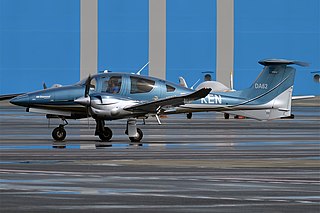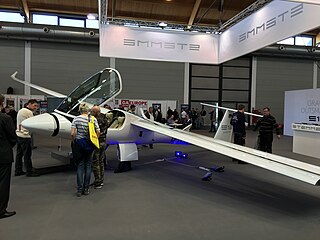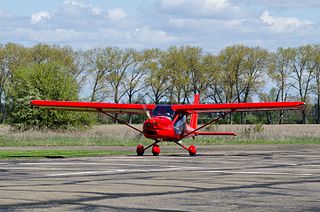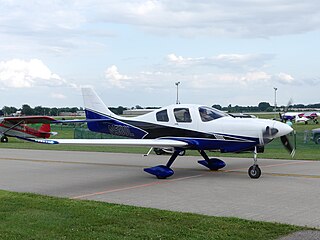
The Piper PA-46 Malibu and Matrix, now known as the M-Class, are a family of American light aircraft manufactured by Piper Aircraft of Vero Beach, Florida. The aircraft is powered by a single engine and has the capacity for one pilot and five passengers. Early Malibus were all piston-engined, but a turboprop version, introduced as the Malibu Meridian but now called the M500, is also available. Currently, Piper offers the M350, M500, and M600 in the PA-46 family.

The Cessna 400, marketed as the Cessna TTx, is a single-engine, fixed-gear, low-wing general aviation aircraft built from composite materials by Cessna Aircraft. The Cessna 400 was originally built by Columbia Aircraft as the Columbia 400 until December 2007. From 2013, the aircraft was built as the Cessna TTx Model T240.

The Cessna 441 Conquest II is the first turboprop powered aircraft designed by Cessna, and was meant to fill the gap between their jets and piston-engined aircraft. It was developed in November 1974, with the first aircraft delivered in September 1977. It is a pressurized, 8–9 passenger turbine development of the Cessna 404 Titan.

The Partenavia P.68, now Vulcanair P68, is a light aircraft designed by Luigi Pascale and initially built by Italian company Partenavia. It made its first flight on 25 May 1970, its type certification was granted on 17 November 1971 and was transferred to Vulcanair in 1998. The original six-seat high-wing monoplane is powered by twin piston engines and is used for light transport and training. The P.68 Observer is an observation aircraft variant, and it was developed in a stretched, 10/11-seat twin turboprop derivative.

The Cessna Citation II are light corporate jets built by Cessna as part of the Citation family. Stretched from the Citation I, the Model 550 was announced in September 1976, first flew on January 31, 1977, and was certified in March 1978. The II/SP is a single pilot version, the improved S/II first flew on February 14, 1984 and the Citation Bravo, a stretched S/II with new avionics and more powerful P&WC PW530A turbofans, first flew on April 25, 1995. The United States Navy adopted a version of the S/II as the T-47A. Production ceased in 2006 after 1,184 of all variants were delivered.

The Sukhoi Su-29 is a Russian two-seat aerobatic aircraft with a 268 kW (360 hp) radial engine. It was designed based on the Su-26 and inherited most of the design and technical features of its predecessor. Due to wide use of composite materials, which make up as much as 60% of the Su-29's aircraft structure, the empty weight is increased by only 50 kg (110 lb) over the single-seat Su-26's empty weight.

The Grob G109 is a light aircraft developed by Grob Aircraft AG of Mindelheim Mattsies in Germany. It first flew in 1980. The G109B followed in 1984. It is a two-seat self-launching motor glider in which the pilot and passenger or student sit side by side, with good visibility provided by large windows.

The Extra EA-500 is a six-seat single-engined high wing turboprop aircraft designed by the Extra Aircraft company. During 2015 a decision was made to end production.

The Yakovlev Yak-50 aerobatic aircraft is a single-seat all-metal low-wing monoplane with retractable main wheels and exposed tail wheel. The control surfaces are fabric-covered to save weight. The aircraft is not equipped with flaps.

The AS/SA 202 Bravo is a two to three-seat civil light aircraft jointly designed and manufactured by the Swiss company Flug- und Fahrzeugwerke Altenrhein (FFA) and the Italian company Savoia-Marchetti. The aircraft was designated the AS 202 in Switzerland, and the SA 202 in Italy.

The Tecnam P2006T is an Italian high-winged twin-engined all-metal light aircraft, built by Costruzioni Aeronautiche Tecnam based in Capua, Italy, near Naples. The P2006T received airworthiness certification in the European Union by EASA under CS23 in 2003, type certification in 2009, and Federal Aviation Administration FAR Part 23 certification in 2010.

The Irkut A-002 is a three-seat, pusher configuration autogyro developed in Russia through the 2000s by the United Constructor Bureau for Light Aircraft team of the Irkutsk Aircraft Production Association (IAPO) "Irkut" as the first independent product. Take-off is possible when wind speed exceeds 8 m/s, otherwise a running start of up to 15 m is necessary. The riveted covering is made of duralumin. The first produced consignment consisted of five autogyros. The A-002M is a further development.
The O'Neill Model J Magnum, also called the Magnum Jake and the Magnum Pickup, is a homebuilt aircraft design for bush flying operations similar to the de Havilland Beaver.

The Diamond DA62 is a five- to seven-seat, twin-engine light aircraft produced by Diamond Aircraft Industries and first announced in March 2012.

The Turbay T-3A was an Argentine twin-engined seven-seater light transport of the 1960s. A single example was built, but no production followed.

The Alpi Pioneer 400 is an Italian four-seat light aircraft, designed produced by Alpi Aviation, of Pordenone. The aircraft is supplied as a kit for amateur construction or as a complete ready-to-fly-aircraft.

The Stemme S12 is a German high-wing, two-seat motor glider produced by Stemme of Strausberg. It was introduced at AERO Friedrichshafen in April 2015, shortly after its first flight.
The Viper Aircraft Viperfan was an American homebuilt aircraft that was designed and produced by Viper Aircraft of Kennewick, Washington, introduced in the late 1990s. The aircraft was intended to be supplied as a kit for amateur construction, but only one was ever built.

The Aeroprakt A-32 is a Ukrainian two-seat, high-wing, tricycle gear ultralight aircraft that was designed by Yuri Yakovlev and is manufactured by Aeroprakt. In Australia the A-32 is referred to as the Vixxen.

The Lancair Mako is an American amateur-built aircraft designed and produced by Lancair of Uvalde, Texas, introduced at AirVenture in 2017. The aircraft was first flown on 18 July 2017 and is supplied as a kit for amateur construction. It is named after the shark.


















